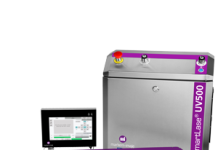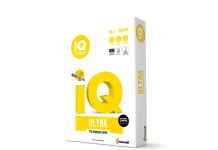Matrix waste (the ladder-like waste that arises during the production of film labels) is created wherever labels are die-cut from a web of label stock. Depending on the shape, size and arrangement of the labels in the web, substantial quantities can arise.
The roll of stripped waste naturally accommodates just as much material, measured in running metres, as the label roll that is subsequently placed in the labelling machine. Although exact figures are not available for the quantity of PE matrix produced worldwide, HERMA has estimated that European converters currently generate around 7300 metric tons of this waste annually.
In a joint project, film manufacturer Polifilm Extrusion and self-adhesive materials specialist HERMA have succeeded in initiating a genuine recycling stream for matrix.
‘In practice, this means that we are recovering a film product and returning it to the production cycle in the form of a high-quality recycled material. The method we are applying also allows the adhesives in particular, as well as the customary printing inks, to be processed,’ said Jens Kölble, who is Head of Packaging and Performance Films at Polifilm.
‘In the initial phase, we are using the recycled material in the production of construction films. Mixing in a small quantity does not impose any restrictions whatsoever regarding either functionality or processing.’
According to Polifilm, groundwork on further film applications is already taking place. The actual quantities of matrix that can be processed at present remains small, however, because a market has yet to be established. Until now there has not been any economically viable or ecologically acceptable recycling solution for PE matrix waste. As a rule, the matrix enters the ‘thermal recovery stream’, otherwise known as incineration. Label printers pay a lot of money for this form of waste management. ‘Apart from the costs, simply destroying precious raw materials cannot be a sensible option from a sustainability perspective. We are always keen to highlight ways of bringing about a circular economy and further reducing the ecological footprint of labels,’ commented Dr. Ulli Nägele, HERMA’s Head of Development.
Matrix recycling, as implemented now by Polifilm, is for the time being limited to PE label film stock. But as Dr. Nägele predicted, ‘It’s only a matter of time before a similar approach is adopted for PP films as well. In the case of PE films, we were certain from the outset that pooling our adhesive skills with Polifilm’s expertise in the recycling and manufacture of films would quickly give rise to workable results.’
Polifilm had already proven its partnering credentials when schäfer-etiketten and HERMA joined forces to develop a PE label, regarded as the first of its kind worldwide, consisting entirely of post-consumer recycled (PCR) material. Even the masterbatch containing the white pigment is a PCR PE product. For a similar project utilising 50 percent PCR and 50 percent industrial PE waste, the three companies were awarded the German Packaging Prize in the sustainability category during 2019.
To submit your news please, contact journo@practicalpublishing.co.za
Read the top 5 stories weekly on WhatsApp or sign up to our newsletter.
HERMA
https://www.herma-labeler.com/
POLIFILM EXTRUSION GmbH
https://www.polifilm.com/





















